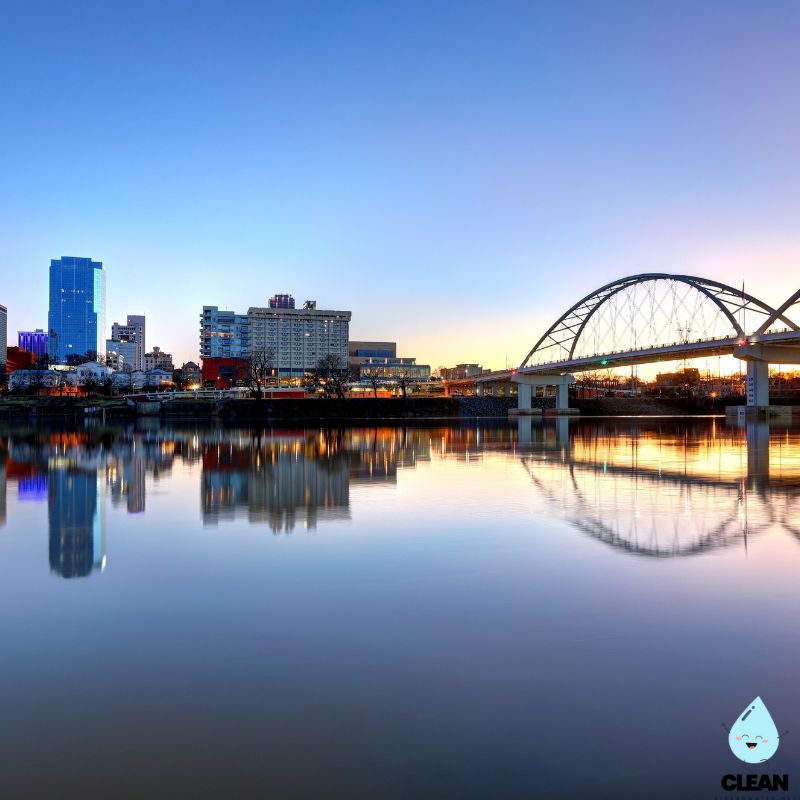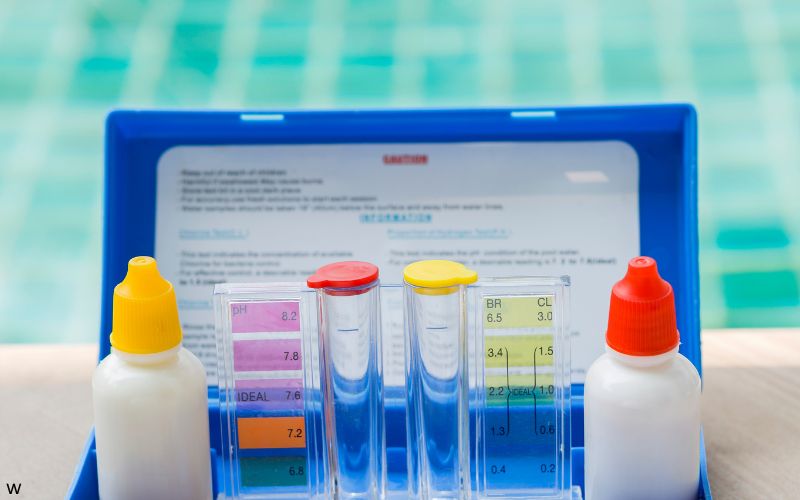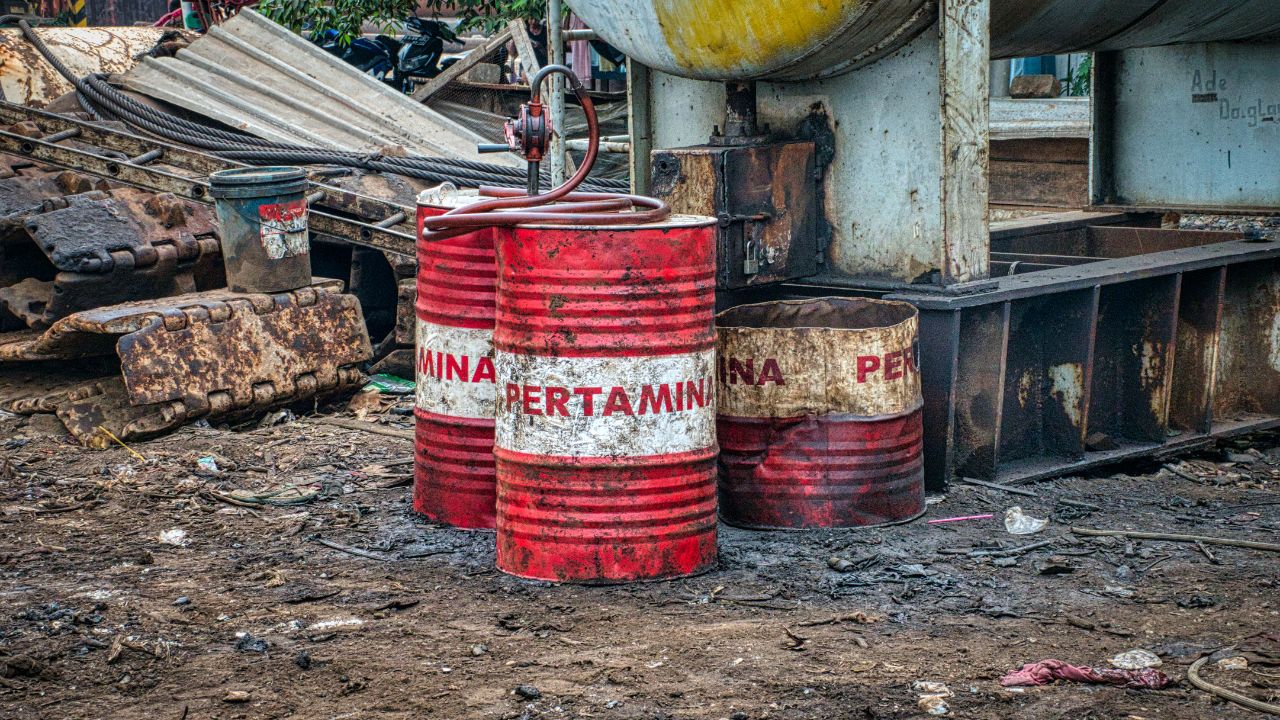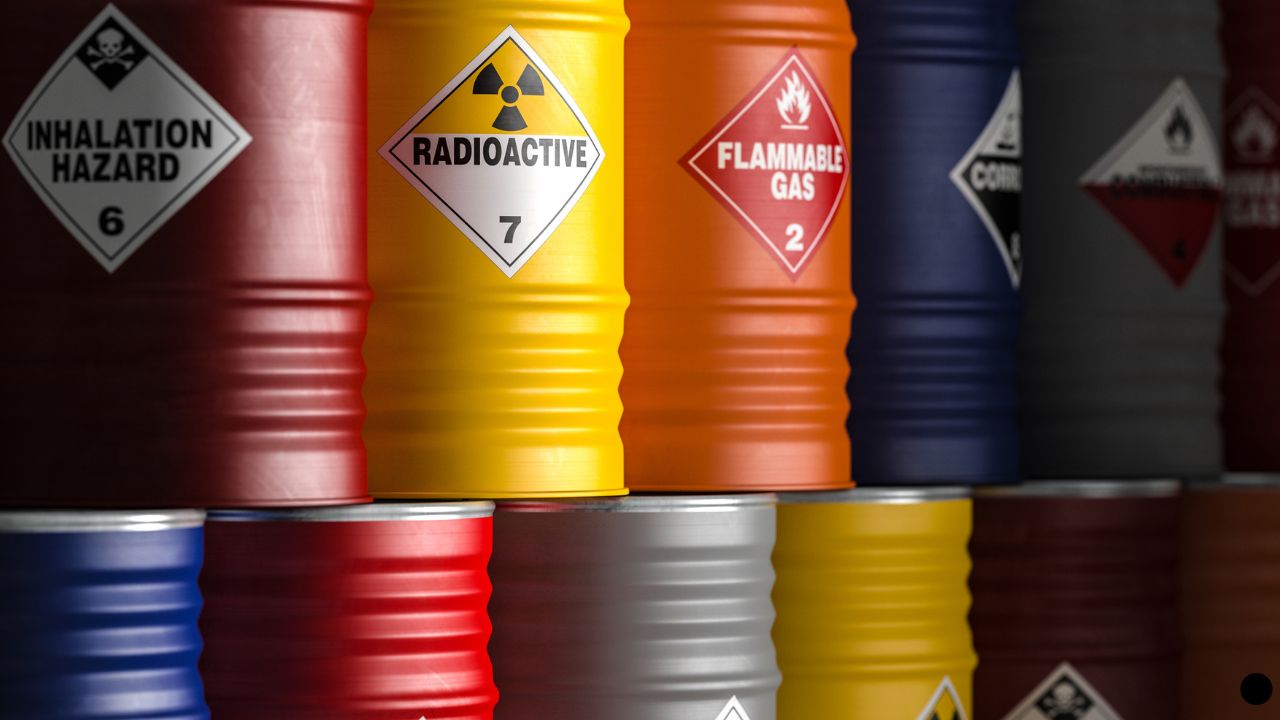Little Rock Water Quality at a Glance
major concerns
Is Little Rock Water Safe to Drink?
Generally Yes, With Significant Caution – Central Arkansas Water meets federal standards and maintains zero Safe Drinking Water Act violations. However, Little Rock Air Force Base shows extreme PFAS contamination (153,000 ppt PFOS), and independent testing reveals exceedances of health guidelines for chromium-6, disinfection byproducts, and other contaminants. The utility serves 450,000 people with water from protected Lake Maumelle and Lake Winona.
⚠️ Key Concerns for Little Rock Residents
- PFAS “Forever Chemicals”: Little Rock Air Force Base shows extreme contamination – PFOS at 153,000 ppt and PFOA at 22,100 ppt (EPA limit: 4 ppt each)
- Chromium-6: Independent testing shows Central Arkansas Water exceeds health guidelines for this cancer-causing chemical
- Disinfection Byproducts: Elevated levels of bromodichloromethane, chloroform, and chlorite from water treatment processes
- Military Contamination: AFFF firefighting foam use at base has created widespread environmental contamination affecting groundwater
Read the full report below for detailed analysis, city-specific data, and actionable recommendations for Little Rock residents.
Little Rock – Arkansas – Water Quality Report 2025: PFAS Testing, Infrastructure Concerns & Safety across your city
Central Arkansas Water serves approximately 450,000 residents across the greater Little Rock metropolitan area, including North Little Rock, Sherwood, Jacksonville, Bryant, Cabot, and numerous surrounding communities in Pulaski, Saline, Lonoke, and Grant counties. As Arkansas’s largest water utility, the system encompasses over 2,770 miles of water distribution lines, multiple treatment facilities, and advanced monitoring systems that deliver an average of 126 million gallons of drinking water daily to the state’s capital region.
Central Arkansas Water sources its drinking water from two pristine surface water reservoirs: Lake Maumelle, located 15 minutes west of Little Rock, provides approximately 65% of the system’s daily demand, while Lake Winona in the Ouachita Mountain foothills supplies the remaining 35%. Raw water is treated at two state-of-the-art facilities – the Jack H. Wilson Water Treatment Plant with a capacity of 133 million gallons per day, and the Ozark Point Water Treatment Plant rated at 24 million gallons per day. The utility maintains an exemplary compliance record with zero Safe Drinking Water Act violations, implementing comprehensive watershed protection, advanced treatment technologies, and proactive infrastructure improvements to ensure safe, reliable water service for future generations in Central Arkansas.

Little Rock Water Quality: Current Status (2024-2025)
Latest Testing Results
- Compliance Excellence: Central Arkansas Water maintains an excellent compliance record with zero Safe Drinking Water Act violations, consistently meeting all EPA and Arkansas Department of Health drinking water standards.
- Contaminant Concerns: Independent testing by third-party organizations has found levels of bromodichloromethane, chloroform, chlorite, and hexavalent chromium that exceed health guidelines, though still within federal compliance limits.
- PFAS Monitoring: Arkansas is implementing statewide PFAS testing of surface waters with $1.8 million in funding, with Little Rock Air Force Base showing severe contamination (PFOS: 153,000 ppt, PFOA: 22,100 ppt – far exceeding EPA limits of 4 ppt each).
Water Sources
- Lake Maumelle: Primary source providing 65% of daily demand, located 15 minutes west of Little Rock covering 13.9 square miles with comprehensive watershed protection covering over 115,000 acres.
- Lake Winona: Secondary source in Saline County providing 35% of supply, a scenic 1.9 square mile reservoir nestled in the Ouachita Mountain foothills with excellent natural protection.
- Jackson Reservoir: Auxiliary regulating reservoir in Little Rock that can receive water from both primary sources, providing system flexibility and supply security.
Advanced Treatment Technology
- Jack H. Wilson Plant: Primary treatment facility with 133 million gallons per day capacity, utilizing multi-barrier treatment including coagulation, flocculation, sedimentation, filtration, and advanced disinfection.
- Ozark Point Plant: Secondary facility with 24 million gallons per day capacity, incorporating advanced treatment processes and redundant systems for exceptional water quality and reliability.
- Combined Capacity: Total treatment capacity of 157 million gallons per day provides adequate supply during peak usage and emergency situations, though emerging contaminants like PFAS require specialized treatment technologies.
Infrastructure Modernization
- Treatment Plant Upgrades: Ongoing improvements to treatment facilities enhance water quality and optimize operations, with potential need for specialized PFAS treatment systems as new EPA regulations take effect.
- Distribution System: Advanced GIS mapping and monitoring of 2,770 miles of water mains, 35,921 valves, 16,376 hydrants, and 151,832 meters across a 530.5 square mile service area.
- Future Investments: Planned infrastructure improvements will need to address emerging contaminant removal, watershed protection, distribution improvements, operational upgrades, and major infrastructure including pipeline replacements.
Customer Protection Initiatives
Central Arkansas Water provides comprehensive customer support through various programs, including low-income assistance providing up to $2,000 in credits for qualifying households, 24/7 emergency service, and convenient online account management. The utility offers educational outreach, conservation programs, and transparent communication through detailed water quality reports. With consolidated operations serving the Central Arkansas region, Central Arkansas Water demonstrates commitment to public health protection through rigorous water quality monitoring, watershed management, and continuous infrastructure improvements while addressing emerging contaminants and maintaining affordable rates for the diverse communities it serves.
Recommendations for Little Rock Residents

Test Your Water
Contact Central Arkansas Water at 501-372-5161 for information about water testing services. Testing is especially recommended for homes built before 1986, residents near Little Rock Air Force Base due to PFAS contamination, or those with concerns about disinfection byproducts.

Conserve Water
Take advantage of Central Arkansas Water’s conservation resources and educational programs. Follow best practices for efficient water use, including proper irrigation timing and leak detection to reduce waste and protect source water quality.

Consider Home Filtration
Given independent testing showing elevated levels of chromium-6, disinfection byproducts, and potential PFAS exposure, NSF-certified filters designed for these specific contaminants are recommended for drinking and cooking water, especially for vulnerable populations.

Apply for Financial Assistance
Qualifying low-income customers can receive up to $2,000 in credits for water and wastewater bills. Visit arkansaslihwap.com or contact Central Arkansas Water at 501-372-5161 for assistance with applications.

Report Issues
Contact Central Arkansas Water Customer Service at 501-372-5161 (available 7:30 AM-5 PM Mon-Thu, 8 AM-4:30 PM Fri) or emergency line 501-377-1239 (24/7) for water main breaks, pressure problems, or quality concerns including taste, odor, or health-related issues.
Frequently Asked Questions
Is Little Rock’s tap water safe to drink?
Generally yes, with significant caution. Little Rock’s tap water meets all federal and state drinking water standards, and Central Arkansas Water maintains an excellent compliance record with zero Safe Drinking Water Act violations.
However, independent testing has found levels of hexavalent chromium, disinfection byproducts (bromodichloromethane, chloroform, chlorite), and other contaminants that exceed health guidelines, though they remain within federal compliance limits. Additionally, severe PFAS contamination at nearby Little Rock Air Force Base (PFOS: 153,000 ppt, PFOA: 22,100 ppt) raises concerns about potential exposure. The water comes from two well-protected sources and undergoes comprehensive treatment, but residents may want to consider filtration for additional protection, especially vulnerable populations.
Why does my water sometimes taste or smell different?
Occasional taste and odor changes can occur due to several factors:
1. Seasonal water quality variations: Natural changes in source water during different weather conditions can affect taste and odor
2. Treatment process changes: Adjustments to disinfection processes or treatment chemicals may temporarily affect water characteristics and can increase disinfection byproduct formation
3. Home plumbing factors: Internal plumbing issues, water heater problems, or infrequently used faucets can sometimes cause taste or odor concerns
If taste or odor issues persist, contact Central Arkansas Water Customer Service at 501-372-5161. Often, running cold water for a few minutes after periods of non-use can help improve water quality from your tap.
What contaminants have been found in Little Rock water?
Independent third-party testing has identified several contaminants of concern in Little Rock’s water supply:
• Hexavalent Chromium (Chromium-6): Cancer-causing chemical that exceeds health guidelines
• Disinfection Byproducts: Bromodichloromethane, chloroform, and chlorite from water treatment processes
• PFAS “Forever Chemicals”: Severe contamination detected at Little Rock Air Force Base with extremely high levels
• Other compounds: Various other contaminants detected at levels within federal compliance but potentially above health-based guidelines
While the water utility meets all federal standards, these findings suggest residents should consider additional protection through certified filtration systems, especially for drinking and cooking water.
What financial assistance is available for water bills?
Central Arkansas Water offers several programs to help customers with water and wastewater bills:
Low-Income Water Assistance Program:
• Up to $2,000 in credits applied to eligible customers’ accounts
• Credits typically cover 12 months of water and wastewater bills
• Eligibility based on household size, income level, and vulnerable household members
Payment Plan Options:
• No-fee payment plans through Promise for customers with past-due balances of $50 or more
• Protection from fees and service disconnections while plans remain current
To apply for assistance, visit arkansaslihwap.com or contact Central Arkansas Water at 501-372-5161. Customer service representatives can help with applications over the phone or in person.
Quality News About Your Water
Get the comprehensive water quality news coverage you need with our dedicated US Water News Service. From coast to coast, we deliver in-depth reporting and expert analysis on PFAS contamination, EPA regulatory changes, infrastructure developments, and emerging water safety issues affecting communities nationwide. While mainstream media only covers the biggest stories, we provide the detailed, ongoing coverage that helps you understand the full scope of America’s water challenges. Whether you’re a concerned citizen, water professional, or community leader, our daily updates and analytical insights keep you informed about the issues that matter most to public health and environmental safety.
Contaminants of Concern

Disinfection Byproducts
Source: Formed when disinfectants such as chlorine react with naturally occurring organic matter in source water from Lakes Maumelle and Winona; levels may vary seasonally
Health Effects: Long-term exposure to elevated levels may increase risk of certain cancers and potentially affect liver, kidney, and central nervous system function; bromodichloromethane, chloroform, and chlorite have been detected above health guidelines
Current Status: Independent testing shows levels exceeding health guidelines for bromodichloromethane, chloroform, and chlorite, though still within federal compliance limits; regular monitoring conducted throughout the distribution system EPA Limits: 80 ppb for total trihalomethanes (TTHMs) and 60 ppb for haloacetic acids (HAA5)

PFAS Compounds
Source: Per- and polyfluoroalkyl substances from industrial activities, military installations (notably Little Rock Air Force Base), and consumer products that can enter surface waters including Central Arkansas watersheds
Health Effects: Research suggests potential impacts on immune system, cholesterol levels, thyroid function, and possible links to certain cancers including kidney and testicular cancer, and reproductive effects
Current Status: Severe contamination detected at Little Rock Air Force Base with PFOS at 153,000 ppt and PFOA at 22,100 ppt (far exceeding EPA limits); Arkansas is implementing comprehensive statewide PFAS testing of surface waters with $1.8 million in funding EPA Limits: New federal drinking water standards: PFOS and PFOA at 4 ppt each, with compliance required by 2029

Hexavalent Chromium
Source: Naturally occurring metal elevated by industrial uses, including degradation from chrome plumbing fixtures and potential industrial pollution affecting Central Arkansas water sources
Health Effects: Classified as a carcinogen that can cause cancer; the chemical gained notoriety from the Erin Brockovich case where it contaminated drinking water and caused severe health issues
Current Status: Independent testing shows Central Arkansas Water exceeds health guidelines for hexavalent chromium, though levels remain within federal compliance limits Health Guidelines: California standard of 0.02 ppb, with EPA reviewing potential federal standards

Lead and Copper
Source: Primarily from corrosion of household plumbing systems, especially in homes built before 1986; Central Arkansas Water uses corrosion control treatment to minimize leaching
Health Effects: Lead exposure can cause serious health problems, especially for pregnant women and young children, affecting brain development and causing learning disabilities
Current Status: Central Arkansas Water maintains excellent lead control with recent testing showing 90% of samples at or below 0.001 mg/L (only 6.7% of EPA action level); service line inventory available online EPA Action Level: 0.015 mg/L for lead
Please read – our information
The information presented on cleanairandwater.net is compiled from official water quality reports, trusted news sources, government websites, and public health resources. While we strive for accuracy and thoroughness in our presentations, we are not scientists, engineers, or qualified water quality professionals.
Our mission is to present water quality information in an accessible, real-world format that helps people understand what’s in their water and make informed decisions about their health and safety. We believe that complex environmental information should be available to everyone in a format that’s easy to understand.
We make every effort to ensure our content is current and accurate, but we cannot guarantee that all information is complete or error-free. This website should not replace official communications from your local water utility or health department. We always recommend consulting official sources for the most up-to-date information regarding your specific water system.
Clean Air and Water is not liable for any unintentional errors, omissions, or outdated information. The content on this site is provided for informational purposes only and should not be considered professional advice.


